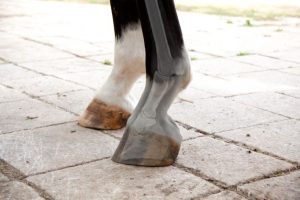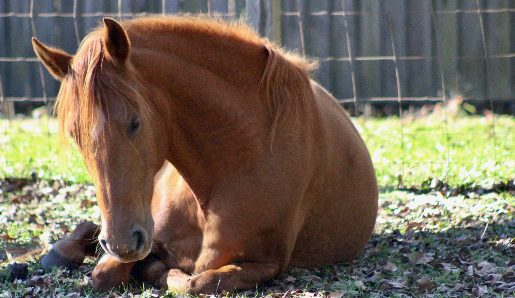When you hear about laminitis in horses, technically this means inflammation of the lamina. The lamina is the soft tissue inside the hoof that holds the coffin bone and hoof wall together. However, scientists now believe that may not be the best description of this condition. “Metabolic Laminitis” — which causes 90% of all laminitis — is more a stretching or a lengthening of the lamina that results in pain and damage.
There are three broad categories of laminitis:
- Metabolic Laminitis (also known as Pasture-associated Laminitis)
- Sepsis-associated Laminitis, 10% of cases are caused by bacteria releasing toxins:
- Grain overload
- Severe diarrhea
- Retained placenta
- Complications from pneumonia
- Toxins like black walnut and hoary alyssum
- Body-wide illness, such as Strangles, Potomac Horse Fever, Lyme Disease
- Supporting-limb Laminitis – Much less common, this occurs when one leg takes more weight temporarily because of lameness or injury, and the extra weight damages the lamina. Examples include road founder, club foot, and long toe/low heel.
What causes laminitis in horses?
The main type of laminitis — metabolic laminitis — can happen when a horse with a metabolic disorder is on a diet that is too high in sugars and starches. This disorder in horses is called Equine Metabolic Syndrome or EMS. One aspect of EMS is insulin resistance (IR), which is faulty insulin production or activity.
Insulin is a hormone released by the pancreas after a meal. The role of insulin is to help sugars from the meal get out of the bloodstream and inside of cells. With IR, insulin does not function properly or cells do not respond to it normally and insulin levels get too high in the bloodstream. Known as “hyperinsulinemia” or HI, experts now believe high insulin levels in the blood are what cause lamina to stretch and become damaged.
Some breeds are prone to problems with insulin. These include ponies, Spanish breeds (e.g. Andalusians), gaited breeds (Saddlebreds, Paso Finos), Morgans, minis, warmbloods, and possibly donkeys. If your horse is overweight or obese they may also have an underlying problem with insulin. Any equine at a higher risk for metabolic laminitis should have their diet and exercise program closely controlled.
How do I know if my horse has laminitis?
An acute bout of severe laminitis may be very painful. In order to relieve the pain, your horse may shift their weight from one foot to another or stand with the front legs stretched out in the classic “sawhorse stance.” Others may be so painful they refuse to move or get up. Most cases of metabolic laminitis have milder signs, such as warm hooves, bounding digital pulses, sweating, and high heart and respiratory rates. If your your horse appears to be “walking on eggshells,” they may have slightly sore feet due to metabolic laminitis. You should contact your veterinarian right away if you notice any of these signs.
How is laminitis in horses prevented?
There are published guidelines for how much and what type of food these horses should eat, as well as how much and how often they should be exercised. The basics include:
- No grain – Feed your horse a ration balancer or multi-vitamin to bridge nutrient gaps between hay and their daily nutrient requirements.
- No or restricted grazing. Instead, muzzle, dry lot, strip graze, or create pasture tracks for your horse.
- Have your horse’s hay analyzed and soak if necessary to remove excess sugars and starches
- Give 1.5 to 2% of your horse’s body weight per day in hay using a slow feeder or small hole hay net
- If your horse is recovering from or prone to laminitis, provide exercise only under the direct care of a veterinarian in order to avoid hoof damage
- Gradually work up to 15 minutes of trotting 5 days a week to improve insulin sensitivity and weight loss (some studies suggest 30 minutes of canter!)
In addition to these rules of thumb, experts advise owners to observe at-risk horses and ponies on a regular basis. You should learn how to assess your horse’s body condition score and cresty neck score, as well as estimate their body weight. When your farrier trims your horse’s hooves, they can pay special attention to the quality of the feet. Your veterinarian may recommend drawing blood to check levels of key indicators of metabolic health.


